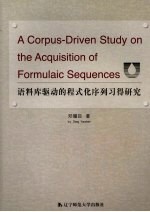

语料库驱动的程式化序列习得研究PDF电子书下载
- 电子书积分:10 积分如何计算积分?
- 作 者:邓耀臣著
- 出 版 社:大连:辽宁师范大学出版社
- 出版年份:2008
- ISBN:9787811037999
- 页数:211 页
Chapter 1 Introduction 1
1.1 Background to the present study 1
1.2 Objectives of the present study 2
1.3 Significance of the present study 3
1.4 Terminological issues 4
1.5 Important features of the present study 5
1.6 Content of remaining chapters 6
Chapter 2 Theoretical Background 8
2.1 Introduction 8
2.2 Defining formulaic sequences 8
2.2.1 Criteria for formulaic sequences 8
2.2.2 Operational definition of formulaic sequences 12
2.3 Theoretical status of formulaic sequences 13
2.3.1 Role of memory in language use 14
2.3.2 The dual-mode system 16
2.4 Nature of formulaic sequences 18
2.4.1 Formulaic sequences as extended units of meaning 19
2.4.2 Formulaic sequences as form-function composites 25
2.5 Classification of formulaic sequences 27
2.5.1 Review of existing taxonomies 28
2.5.2 A proposed taxonomy for the present study 31
2.6 Summary 37
Chapter 3 Formulaic Sequences and Language Learning 39
3.1 Introduction 39
3.2 Roles of formulaic sequences in language learning and language development 39
3.2.1 Achieving native-like selection and native-like fluency 39
3.2.2 Supporting social interaction 41
3.2.3 Facilitating language development 42
3.3 Related empirical studies on formulaic sequences 44
3.3.1 Formulaic sequences use in EFL learner English 45
3.3.2 Formulaic sequences development in EFL learner English 50
3.3.3 Factors influencing formulaic sequence learning 53
3.4 Summary 55
Chapter 4 Conceptual Framework and Research Design 56
4.1 Introduction 56
4.2 A tentative framework for formulaic sequence studies 56
4.3 Research questions 59
4.4 Research methodology:A corpus-driven multiple comparison approach to formulaic sequences 59
4.4.1 Advantages of a corpus-driven approach 59
4.4.2 A corpus-driven multiple comparison approach 60
4.5 Corpora used in the present study 63
4.5.1 COET and MICASE 63
4.5.2 TCELT—the ELT textbook corpus 67
4.5.3 PFR—L1 corpus 68
4.6 Tools and procedures for data analysis 69
4.6.1 Tools for formulaic sequence extraction 69
4.6.2 Tools for formulaic sequence analysis 72
4.6.3 Procedures for data analysis 73
4.7 Summary 74
Chapter 5 Automatic Extraction of Formulaic Sequences 75
5.1 Introduction 75
5.2 Current approaches to formulaic sequence extraction in SLA 75
5.2.1 Intuition-based approach 76
5.2.2 Frequency-driven approach 77
5.2.3 Semantics-oriented approach 79
5.3 A proposed approach:Combining a lexicon-based symbolic algorithm with a collocation-based statistical algorithm 80
5.3.1 Overview of the proposed approach 80
5.3.2 The lexicon-based symbolic algorithm 81
5.3.3 The collocation-based statistical algorithm 82
5.3.4 The language filter 86
5.4 Experiment 88
5.5 Evaluation 88
5.5.1 Complementary effect of the two algorithms 89
5.5.2 The hybrid approach and the semantics-oriented approach 91
5.5.3 Robustness of formulaic sequence extraction from learner corpora 93
5.6 Discussion and conclusion 94
Chapter 6 Formulaic Sequences in EFL Learners'Spoken English(Ⅰ) 95
6.1 Introduction 95
6.2 Amount of formulaic sequence use 95
6.2.1 Quantitative features of formulaic sequence use 96
6.2.2 Quantitative features of formulaic sequence development 109
6.3 Formal features of formulaic sequences 114
6.3.1 Distributional features of formulaic sequences in form 115
6.3.2 Developmental features of formulaic sequences in form 121
6.4 Summary 124
Chapter 7 Formulaic Sequences in EFL Learners'Spoken English(Ⅱ) 126
7.1 Introduction 126
7.2 Semantic features of formulaic sequences 126
7.2.1 Meanings of formulaic routines 128
7.2.2 Meanings of formulaie patterns 139
7.3 Functional features of formulaic sequences 158
7.3.1 Distinctive features of functional use 160
7.3.2 Developmental patterns of functional use 179
7.4 Summary 184
Chapter 8 Major Findings,Implications and Recommendations 186
8.1 Introduction 186
8.2 Summary of the major findings 186
8.2.1 The distinctive patterns of formulaic sequence use 186
8.2.2 The patterns of formulaic sequence development 187
8.2.3 The mechanism manipulating the dual mode system 188
8.2.4 The factors influencing formulaic sequence learning 189
8.3 Implications 190
8.3.1 Theoretical implications 190
8.3.2 Pedagogical implications 190
8.4 Limitations of the present research 191
8.5 Recommendations for future research 192
References 194
Appendices 210
- 《序列密码分析与设计》关杰,丁林,张凯著 2019
- 《我的第一套编程启蒙绘本 123 序列来啦》编程猫教研团队编绘 2019
- 《玩转智能机器人程小奔》马红亮,葛文双 2018
- 《英语视听说教程 看美剧,练口语,学文化》李璐 2019
- 《英汉程式语心理表征对比研究》贾冠杰,王云,李更春 2019
- 《语料库驱动的短语配价型式研究》甄凤超著 2019
- 《安全协议形式化分析与验证》肖美华著 2019
- 《内蒙古历史与文化汉英平行语料库构建研究》 2019
- 《语料库与学术英语研究》姜峰著 2019
- 《钢琴即兴伴奏公式化教程》杜梦萦责任编辑;(中国)陈飞 2019
- 《大学计算机实验指导及习题解答》曹成志,宋长龙 2019
- 《大学生心理健康与人生发展》王琳责任编辑;(中国)肖宇 2019
- 《大学英语四级考试全真试题 标准模拟 四级》汪开虎主编 2012
- 《大学英语教学的跨文化交际视角研究与创新发展》许丽云,刘枫,尚利明著 2020
- 《复旦大学新闻学院教授学术丛书 新闻实务随想录》刘海贵 2019
- 《大学英语综合教程 1》王佃春,骆敏主编 2015
- 《大学物理简明教程 下 第2版》施卫主编 2020
- 《大学化学实验》李爱勤,侯学会主编 2016
- 《中国十大出版家》王震,贺越明著 1991
- 《近代民营出版机构的英语函授教育 以“商务、中华、开明”函授学校为个案 1915年-1946年版》丁伟 2017
